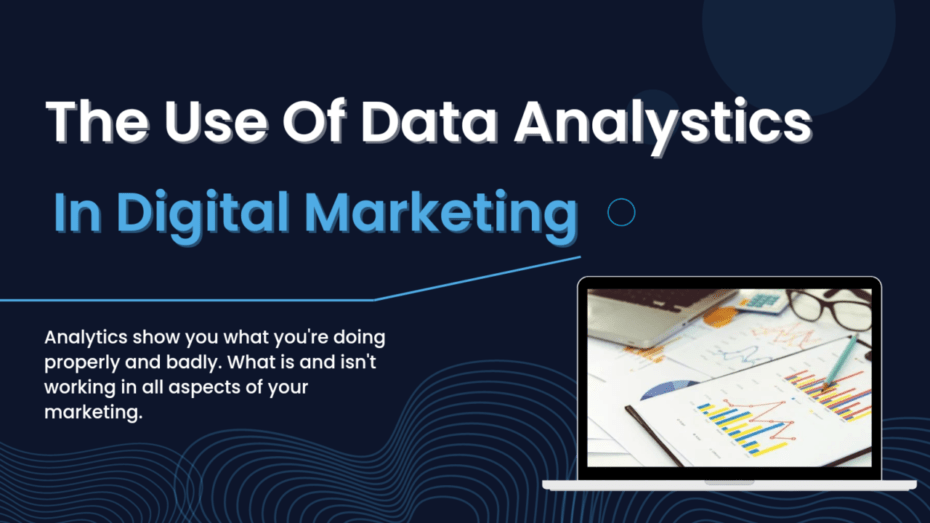The use of data analytics in digital marketing! Data analytics must be at the center of your digital marketing efforts when developing an efficient marketing plan for your business. Because today’s customers want the best, brands must consistently provide tailored experiences for their products and services.
Using data analytics to influence your business goals, marketing strategy, product development, and customer engagement and retention. Analytics show you what you’re doing properly and badly. What is and isn’t working in all aspects of your marketing.
How Can Data Analytics And Digital Marketing Support Your Strategy
A variety of data analytics might be beneficial to your digital marketing approach. Here are several examples:
1. Accurate Data – Making good marketing decisions is impossible without correct data. You can ruin your digital marketing plan if you use the data wrong.
To measure campaign performance, begin with your key performance indicators (KPIs). These metrics can include how many visitors arrive to the site, who signed up for email, landing page visits, and more.
2. Understanding Your Audience – Data analytics may help you figure out who your audience is and who you should be targeting. This aids in the development of personas around which to base your digital marketing approach.
You’ll know what campaigns to launch, what sorts of advertising to utilize, and what content to include in your email marketing campaign.
3. Employ the Correct Keyword – Data analytics and digital marketing perform well when the correct keywords are used. The data reveals what the audience looks for while browsing for products and services.
This allows you to target audiences with those keywords in order to increase traffic and discover new terms.
4. Appropriate Optimization – Appropriate optimization assists in determining whether budget should be utilized or adjusted. You may also optimize your advertising depending on audience demographics or product or service personas.
Data Analytics And Digital Marketing Tools
Data analytics and digital marketing are ineffective without the proper tools are in place. These technologies can assist in gathering information, testing new approaches and ideas, monitoring activity, and linking action to income.
Event Based Tools – Event-based Track a user’s behavior across all touchpoints with your brand. App analytics platforms, marketing automation, and web analytics are examples of these tools.
A/B Testing Tools – A/B testing allows you to test many variants of your website’s features, a social networking platform, or an app. This provides your company with real-world data and insight into how to develop your product by understanding what customers enjoy and how to convert them.
Visual Behavior Tool – Most analytics display the data as a heat map, highlighting the portions that are routinely clicked or visited. Brands may use visual behavior to restructure how they function digitally in order to improve the consumer experience and provide better services.
Display Ads Tool – These statistics are focused on display or banner advertising, which is critical in attracting customers to click through to a landing page to buy or subscribe to a service. You may monitor clicks and conversions, as well as how many individuals interacted, among other things.
Predictive Analysis Tool – Based on their target audiences, this data assists marketers in identifying potential consumers and marketing additional items that customers may be interested in. This also offers information on which items may be effective during a cross-sell.
SEO Tools – SEO tools can tell you how probable it is that your website’s content will appear in search engine results pages. They also provide suggestions to increase your website’s search rating, offer new keywords, and allow you to compare your website to that of your higher-ranked competitors.
Social Media Tools – Social media analytics give essential information on whether your marketing efforts on social platforms are producing actual benefits.
Best Ways To Analyze Digital Marketing Metrics
1. Sales Revenue – Sales revenue is the first measure to track and evaluate. Use a software package that specializes in measuring sales data and other key performance indicators to accurately measure your sales income (KPIs).
The aim is to observe a distinct differential and year-over-year rise in revenue that can be attributed to your digital marketing activities.
2. Client Retention Rate – Monitoring your client retention rate is critical. This measure is reasonably straightforward to track if you collect basic information, such as time between transactions and repeat purchase rate.
This allows you to monitor how effectively your current clients are retained and how to increase this rate over time through marketing initiatives such as retargeting ads.
3. Social Media Engagement – When it comes to the lifetime of your brand and how people connect with your organization over time, social media engagement is one of the most crucial metrics to track.
Focus on consolidating your social media accounts into one extremely efficient social media scheduling app to analyze engagement rates.
4. Cost Per Click – The cost per click metric reflects how effectively you reach people who are likely to click on your ad. It is simply the number of clicks on a certain digital ad in relation to the amount of money spent advertising it.
5. Website Traffic – To begin monitoring site traffic, you may use Google Analytics to monitor your site and embed site traffic data plugins on your site.
Utilizing these can provide you with a clear picture of your site traffic and which digital marketing efforts are doing the best for your business.
6. Return On Advertising Spend – This metric compares the amount of money spent on ads to the amount of money generated on sales directly related to advertisements.
Basically, you should be earning more than you spend on advertising, and this is a terrific method to see if your investment is paying off.
7. Conversion Rates – It’s a measure you should pay close attention to. Conversion rates are the percentage of people who fulfill a desired goal, such as visits to your website or audience members who engage with your adverts. High conversion rates indicate that your marketing plan and website are doing well.
Digital Metrics Examples
It’s up to digital marketers to figure out which measurements or key performance indicators (KPIs) are relevant to their clients and industries.
Digital Metrics for Websites: Given that most channels bring a visitor to the website to complete a desired action, web analytics provides some of the most important data for digital marketing analytics.
The digital analytics available on your website may inform user experience and map out exactly where visitors chose to consume website content or depart your site.
(DM) Lead Generation: Visitors that register their information in a lead generating form and choose to receive material from a company have effectively become leads. As a result, lead generation analytics are largely concerned with a visitor’s deliberate activities.
Email Marketing: The following metrics are used in digital marketing analytics to assess the effectiveness of email CTAs, the effectiveness of subject lines in grabbing leads’ attention, and the quality of email lists.
Digital Metrics for Content Marketing: Bounce rates, for example, might tell a marketer if a user landed on a relevant page. Time spent on a page can also indicate if a reader found the material useful or intriguing.






